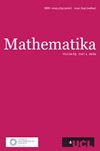用单价符号强化利特尔伍德从属性原理
IF 0.8
3区 数学
Q2 MATHEMATICS
引用次数: 0
摘要
设 是以复数平面原点为中心的开放单位圆盘上的次谐函数,且设 是全纯函数,使得 。一个被称为 Littlewood 从属性原理的经典结果指出, , 和 分别是函数 和 的在以原点为中心的半径圆上的积分。在本注释中,我们意外地改进了利特尔伍德从属性原理在函数为单值时的应用,证明了本文章由计算机程序翻译,如有差异,请以英文原文为准。

Sharpening Littlewood subordination principle with univalent symbol
Let be a subharmonic function on the open unit disc , centered at the origin of the complex plane, and let be a holomorphic function such that . A classical result, known as Littlewood subordination principle, states , where and are integral means over the circle of radius centered at the origin, of the functions and , respectively. In this note, we obtain an unexpected improvement of Littlewood subordination principle in the case when the function is univalent, by proving that
求助全文
通过发布文献求助,成功后即可免费获取论文全文。
去求助
来源期刊

Mathematika
MATHEMATICS, APPLIED-MATHEMATICS
CiteScore
1.40
自引率
0.00%
发文量
60
审稿时长
>12 weeks
期刊介绍:
Mathematika publishes both pure and applied mathematical articles and has done so continuously since its founding by Harold Davenport in the 1950s. The traditional emphasis has been towards the purer side of mathematics but applied mathematics and articles addressing both aspects are equally welcome. The journal is published by the London Mathematical Society, on behalf of its owner University College London, and will continue to publish research papers of the highest mathematical quality.
 求助内容:
求助内容: 应助结果提醒方式:
应助结果提醒方式:


